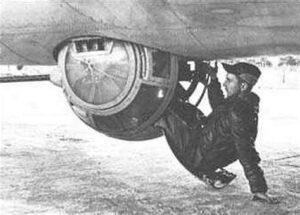
 There are many heroes is a war, and World War II is no exception. Because my dad, Allen Spencer served on a B-17, and was a Flight engineer and Top Turret Gunner, I have always had a special spot in my heart for the Flying Fortress. After all it is the plane that safely brought my dad back from the war so he could be my dad. Most people, who know anything about the B-17, know that the most dangerous station on the B-17 is the Ball Turret. In fact, the average life span of a ball turret gunner in battle is 12 seconds…seriously!! The bad thing for the ball turret gunner is that because it is a small space, the job goes to the smallest man in the group, and if there isn’t anyone who is 5’7″ or shorter, they have to find one. That is basically how Frank Perez ended up in that spot. It was very unexpected, because he trained in Biloxi, Mississippi at the B-24 training base, so it was expected that he would be assigned to a B-24.
There are many heroes is a war, and World War II is no exception. Because my dad, Allen Spencer served on a B-17, and was a Flight engineer and Top Turret Gunner, I have always had a special spot in my heart for the Flying Fortress. After all it is the plane that safely brought my dad back from the war so he could be my dad. Most people, who know anything about the B-17, know that the most dangerous station on the B-17 is the Ball Turret. In fact, the average life span of a ball turret gunner in battle is 12 seconds…seriously!! The bad thing for the ball turret gunner is that because it is a small space, the job goes to the smallest man in the group, and if there isn’t anyone who is 5’7″ or shorter, they have to find one. That is basically how Frank Perez ended up in that spot. It was very unexpected, because he trained in Biloxi, Mississippi at the B-24 training base, so it was expected that he would be assigned to a B-24.
Frank expected to be assigned to a B-24 crew but due to the “needs of the service,” Frank was assigned to the Lieutenant John J Connolly crew of a B-17 Flying Fortress. The B-17 crew already had a flight engineer, so Frank was selected for the ball turret gunner position. Knowing what I know about the ball turret gunner and knowing that anyone who knew about the B-17 also knew about the life span of a ball turret gunner, I’m quite sure that Perez instantly felt just a little bit sick to his stomach…a feeling that would be justified later. Perez had to fly for a time with a different crew while his crew finished some training. Then, he contracted pneumonia, and he was down for a month.
Finally, on July 28, 1944, Perez started flying with his crew again. Their target was the synthetic oil and ammonia plant at Merseburg, Germany. As we know, all combat missions were dangerous, but for Perez, this particular mission to Ludwigshaven, Germany, would really test his faith. Ludwigshaven was the site of large marshalling (railway) yards and a railroad depot. When the bombing run was completed, the B-17s headed back to their base in England. One of the most dangerous parts of a bombing run is maneuvering through the anti-aircraft guns with their flak. Frank’s B-17 was hit by flak and began tumbling and rolling out of control as it quickly lost altitude from about 30 thousand feet. The plane was still over Germany, and Perez could not get out of the ball turret due to the centrifugal force created as the plane fell from the sky. All he could do is watch in horror as the ground got closer and closer. He called the pilot on the intercom. No answer. Then he called “anyone.” No answer. He had to assume that he was the only survivor left…and that would not be for long.
Perez was sure that his life was over, so he started to pray. He prayed, “Well, God, if this is the way it has to be, let it be.” It was a noble prayer, but as he said, “I was under tension and wanted to live. But when I said that, at that instant, everything was just as peaceful as it can get. [I] had my whole life flash before me…from the time I was a little kid to that moment. I mean just like a movie but going like that [he snaps his fingers]. It’s hard to explain…like if you get killed, so what…you just don’t care.” It was his way of resigning himself to his fate and, then…the B-17 pulled up.
The flak might have knocked them out, and some were likely injured, but they were alive. The plane flew in at treetop level with only two of the four engines working. The crew, in an effort to lighten the load, began throwing unnecessary equipment and supplies out of the plane. Perez was still in the ball turret, as he had been for the entire mission. Finally, he saw the White Cliffs of Dover on the English coastline and knew that they 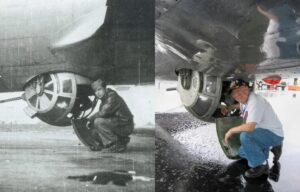
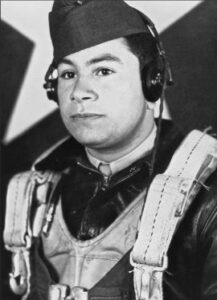 were going to make it. The B-17 was able to land at a B-24 base in England, where it was repaired.
were going to make it. The B-17 was able to land at a B-24 base in England, where it was repaired.
After completing his required combat missions, Perez was discharged and sailed home to the United States. He was back in the US before December 16, 1944. Surviving the ball turret was the saving grace for Perez, who went on to live a long and fruitful life. He died January 16, 2015, two days after his 91st birthday.
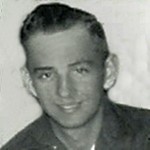 My uncle, Wayne Byer has always been a hardworking man. Even in his retirement years, he likes to stay busy. In fact, he might be on the go more, now that his is retired, than he was before. That isn’t so unusual really. When I retired, my activities have multiplied…almost taken on a mind of their own. Uncle Wayne has been much that way too, but he retired long before I did, so his activities list is most likely much bigger than mine. He likes tinkering in his garage, making things, and repairing things. It gives him a sense of satisfaction.
My uncle, Wayne Byer has always been a hardworking man. Even in his retirement years, he likes to stay busy. In fact, he might be on the go more, now that his is retired, than he was before. That isn’t so unusual really. When I retired, my activities have multiplied…almost taken on a mind of their own. Uncle Wayne has been much that way too, but he retired long before I did, so his activities list is most likely much bigger than mine. He likes tinkering in his garage, making things, and repairing things. It gives him a sense of satisfaction.
Uncle Wayne Being a mechanic at the school bus garage, and later the head of the school bus garage, he was tasked with making sure that every bus was in good repair, 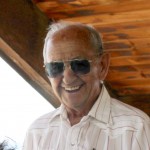 so that the busses would all transport the children safely to their destination. Because we lived in town, my sisters and I didn’t have to ride the bus to school. Later, because my husband, Bob and I lived in the country when our girls were little, they took the bus to school every day. It was then that I really understood just how important my Uncle Wayne’s work was. Nothing brings safety home to you like having your kids be the ones who are being kept safe. And that’s what my uncle did…kept my kids safe, by making sure the busses were safe. My girls always liked the fact that their great uncle took care of the school buses they rode. I think they also liked it when they could tell people that it was their great uncle who headed up the garage. They were very proud of what he did.
so that the busses would all transport the children safely to their destination. Because we lived in town, my sisters and I didn’t have to ride the bus to school. Later, because my husband, Bob and I lived in the country when our girls were little, they took the bus to school every day. It was then that I really understood just how important my Uncle Wayne’s work was. Nothing brings safety home to you like having your kids be the ones who are being kept safe. And that’s what my uncle did…kept my kids safe, by making sure the busses were safe. My girls always liked the fact that their great uncle took care of the school buses they rode. I think they also liked it when they could tell people that it was their great uncle who headed up the garage. They were very proud of what he did.
Uncle Wayne always had a soft spot for kids. He loved to make them laugh and they loved his jokes. I 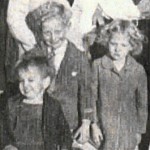 remember, as a kid when he would pop his dentures out All of the kids tried really hard to do the same. We really thought there must be some trick to it…at least until we got older. Uncle Wayne loved to laugh and was always such a happy guy. It totally endeared him to all of us. Looking back on my childhood, Uncle Wayne is in many of my fondest memories. He was my mother, Collene Spencer’s younger brother, and the third in their mischievous three. Together with their brother, Larry Byer, these three managed to get under Grandma Byer’s skin more than any of the others, most of the time anyway. Nevertheless, she loved all nine of her children…even her mischievous middle three. Today is Uncle Wayne’s 85th birthday. Happy birthday Uncle Wayne!! Have a great day!! We love you!!
remember, as a kid when he would pop his dentures out All of the kids tried really hard to do the same. We really thought there must be some trick to it…at least until we got older. Uncle Wayne loved to laugh and was always such a happy guy. It totally endeared him to all of us. Looking back on my childhood, Uncle Wayne is in many of my fondest memories. He was my mother, Collene Spencer’s younger brother, and the third in their mischievous three. Together with their brother, Larry Byer, these three managed to get under Grandma Byer’s skin more than any of the others, most of the time anyway. Nevertheless, she loved all nine of her children…even her mischievous middle three. Today is Uncle Wayne’s 85th birthday. Happy birthday Uncle Wayne!! Have a great day!! We love you!!
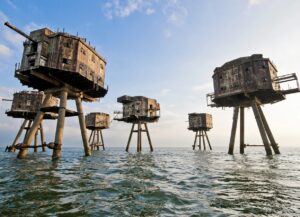 At the mouths of the Thames and Mersey rivers in the United Kingdom, you can still see what amounts to the remains of the Maunsell Forts. These forts are armed towers built during the Second World War to help defend the United Kingdom. At that time, they were operated as army and navy forts. They were named after their designer, Guy Maunsell. When the war ended, so did the need for the forts, and they were decommissioned in the late 1950s. They weren’t torn down, however, and were later used for other activities, including pirate radio broadcasting. Later it was found that they were not really stable enough for use, and the broadcasting stopped.
At the mouths of the Thames and Mersey rivers in the United Kingdom, you can still see what amounts to the remains of the Maunsell Forts. These forts are armed towers built during the Second World War to help defend the United Kingdom. At that time, they were operated as army and navy forts. They were named after their designer, Guy Maunsell. When the war ended, so did the need for the forts, and they were decommissioned in the late 1950s. They weren’t torn down, however, and were later used for other activities, including pirate radio broadcasting. Later it was found that they were not really stable enough for use, and the broadcasting stopped.
The Maunsell naval forts were built in the mouth of the Thames and operated by the Royal Navy. Their purpose was to deter and report German air raids following the Thames as a landmark and prevent attempts to lay mines by aircraft in this important shipping channel. There were four naval forts: 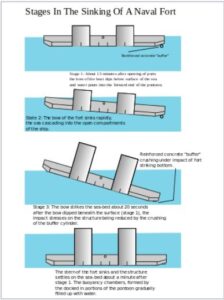 Rough Sands (HM Fort Roughs) (U1), Sunk Head (U2), Tongue Sands (U3), Knock John (U4). In reality it was an artificial naval installation, and it is similar in some respects to early “fixed” offshore oil platforms. “Each fort consisted of a rectangular 168-by-88-foot reinforced concrete pontoon base with a support superstructure of two 60-foot tall, 24-foot diameter hollow reinforced concrete towers. The walls were roughly 3.5 inches thick. The overall weight of each fort is estimated to have been approximately 4,500 tons. Everything was a useful space. The twin concrete supporting towers were actually divided into seven floors. Four of the floors were used for crew quarters. The rest of the floors were used for dining, operational, and storage areas for several generators, and for freshwater tanks and anti-aircraft munitions. There was a steel framework at one end supporting a landing jetty and crane which was used to hoist supplies aboard. The wooden landing stage itself became known as a ‘dolphin.'” A dolphin is “a group of pilings arrayed together to serve variously as a protective hardpoint along a dock, in a waterway, or along a shore; as a means or point of stabilization of a dock, bridge, or similar structure; as a mooring point; and as a base for navigational aids.”
Rough Sands (HM Fort Roughs) (U1), Sunk Head (U2), Tongue Sands (U3), Knock John (U4). In reality it was an artificial naval installation, and it is similar in some respects to early “fixed” offshore oil platforms. “Each fort consisted of a rectangular 168-by-88-foot reinforced concrete pontoon base with a support superstructure of two 60-foot tall, 24-foot diameter hollow reinforced concrete towers. The walls were roughly 3.5 inches thick. The overall weight of each fort is estimated to have been approximately 4,500 tons. Everything was a useful space. The twin concrete supporting towers were actually divided into seven floors. Four of the floors were used for crew quarters. The rest of the floors were used for dining, operational, and storage areas for several generators, and for freshwater tanks and anti-aircraft munitions. There was a steel framework at one end supporting a landing jetty and crane which was used to hoist supplies aboard. The wooden landing stage itself became known as a ‘dolphin.'” A dolphin is “a group of pilings arrayed together to serve variously as a protective hardpoint along a dock, in a waterway, or along a shore; as a means or point of stabilization of a dock, bridge, or similar structure; as a mooring point; and as a base for navigational aids.”
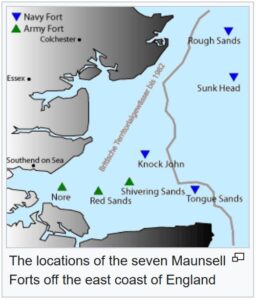
“The towers were joined together above the waterline by a steel platform deck. Other structures could be added as needed. That area was also the gun deck, on which an upper deck and a central tower unit were constructed. QF 3.7 anti-aircraft guns were positioned at each end of this main deck, and two Bofors 40 mm anti-aircraft guns and the central tower radar installations atop a central living area that contained a galley, medical, and officers’ quarters. The design of these concrete structures is equal to a military grade bunker, due to the ends of the stilts, (under water) that are solidly locked into the ground. They were laid down in dry dock and assembled as complete units. They were then fitted out, and the crews went on board at the same time for familiarization, before being towed out and sunk onto their sand bank positions in 1942.” They also had some unexpected uses. Many species of fish live near the forts because the forts create cover…who would have thought about that. The forts have also provided landmark references for shipping…an added perk.
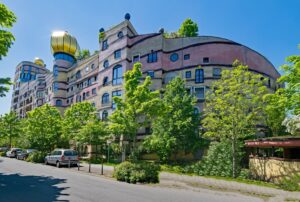 We have come to expect apartment buildings to look pretty much the same. There might be a few structural differences, but basically the idea is small homes stacked on top of each other, so that multiple families can be housed is a relatively small space. These days I have seen more buildings that look almost like very large houses, mansions even, but the reality is that they buildings house many families, and the apartments are rather cookie-cutter and plain.
We have come to expect apartment buildings to look pretty much the same. There might be a few structural differences, but basically the idea is small homes stacked on top of each other, so that multiple families can be housed is a relatively small space. These days I have seen more buildings that look almost like very large houses, mansions even, but the reality is that they buildings house many families, and the apartments are rather cookie-cutter and plain.
One building…the Waldspirale, which means forest spiral in English, is not just another random residential building. Designed by Friedensreich 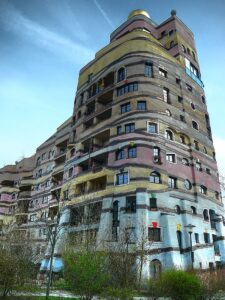 Hundertwasser, this architectural wonder located in Darmstadt in Germany. Construction began at the end of 1990s and was completed in 2000. This building is no ordinary structure. The U-shape of the building is characterized by unique multicolored facade and lack of straight lines. The plan was to make sure that no other building looked quite like this one. The inside of the building is just as unique as the outside. The inner wall corners are rounded to match the outer walls of the building. The building has 105 apartments, a garage, and a playground for children…with a tiny artificial lake…much more than the average apartment building in the 90s. The building is really irregularly shaped, and while it seems short, the highest point of the building goes up to the 12th floor. That is all interesting, but what I find the most interesting is that not one of the 1000 windows in the building are the same and the handles on the doors are also different. Imagine just finding 1000 different windows and probably as many different doors too.
Hundertwasser, this architectural wonder located in Darmstadt in Germany. Construction began at the end of 1990s and was completed in 2000. This building is no ordinary structure. The U-shape of the building is characterized by unique multicolored facade and lack of straight lines. The plan was to make sure that no other building looked quite like this one. The inside of the building is just as unique as the outside. The inner wall corners are rounded to match the outer walls of the building. The building has 105 apartments, a garage, and a playground for children…with a tiny artificial lake…much more than the average apartment building in the 90s. The building is really irregularly shaped, and while it seems short, the highest point of the building goes up to the 12th floor. That is all interesting, but what I find the most interesting is that not one of the 1000 windows in the building are the same and the handles on the doors are also different. Imagine just finding 1000 different windows and probably as many different doors too.
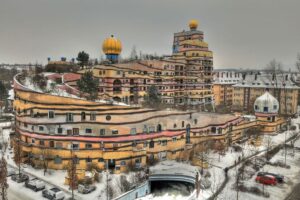 While it was designed by Austrian artist Friedensreich Hundertwasser, it was planned and implemented by architect Heinz M Springmann and constructed by the Bauverein Darmstadt company. I’m sure the uniqueness of the building, while somewhat simple to design, would take a lot of planning and the structure would take some special planning to make it stable enough to carry out the structure as it was designed the uniqueness of the plan. Since I, like many other people have watched the DIY channels, I know that the more unique the structure the more work goes into making it stable. While some people might consider it weird to live in such a building, I think it might be kind of fun.
While it was designed by Austrian artist Friedensreich Hundertwasser, it was planned and implemented by architect Heinz M Springmann and constructed by the Bauverein Darmstadt company. I’m sure the uniqueness of the building, while somewhat simple to design, would take a lot of planning and the structure would take some special planning to make it stable enough to carry out the structure as it was designed the uniqueness of the plan. Since I, like many other people have watched the DIY channels, I know that the more unique the structure the more work goes into making it stable. While some people might consider it weird to live in such a building, I think it might be kind of fun.
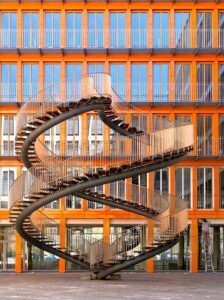
 Is it art or is it an exercise machine? I suppose it depends on your perspective. The strange staircase that doubles as a beautiful piece of art is located in the courtyard of an office building in Munich, hidden from public view for the most part. At first glance, it looks like a spiral staircase that is…just a little bit odd looking…like it’s a double staircase. Then a staircase seemingly leads you up…to nowhere, aaround and back to the bottom again. “Umschreibung” is not really a staircase at all. It’s actually an ominous sculpture by Danish artist Olafur Eliasson. “Umschreibung” is a German word which means “euphemism,” or “circumlocution,” the second of these made sense to me because the structure is repetitive, but the first definition didn’t, because an alternative just didn’t fit. The “Umschreibung” web site translates it to “circumscription” or “periphrasis,” meaning “a movement without destination, a space defined by motion rather than walls.” That idea is interesting and much like exercise equipment, because that is what a treadmill or exercise bike does.
Is it art or is it an exercise machine? I suppose it depends on your perspective. The strange staircase that doubles as a beautiful piece of art is located in the courtyard of an office building in Munich, hidden from public view for the most part. At first glance, it looks like a spiral staircase that is…just a little bit odd looking…like it’s a double staircase. Then a staircase seemingly leads you up…to nowhere, aaround and back to the bottom again. “Umschreibung” is not really a staircase at all. It’s actually an ominous sculpture by Danish artist Olafur Eliasson. “Umschreibung” is a German word which means “euphemism,” or “circumlocution,” the second of these made sense to me because the structure is repetitive, but the first definition didn’t, because an alternative just didn’t fit. The “Umschreibung” web site translates it to “circumscription” or “periphrasis,” meaning “a movement without destination, a space defined by motion rather than walls.” That idea is interesting and much like exercise equipment, because that is what a treadmill or exercise bike does.
The 30-foot-tall sculpture is made of steel. Basically, it is a staircase in the shape of a double helix. At the bottom of the staircase there is a small opening. It’s just the right size for an entrance, so you can actually climb the stairs yourself. I don’t know if that is allowed now or not, but it looks like it was once or is 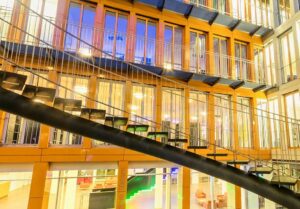
 sometimes. The view I saw of it has a small chain on each side of the entrance as a way of closure. If it is not allowed, I think it is a really sad thing. A staircase is meant to be climbed. The “Endless Staircase” is, as I said, located in the courtyard of an office building, and I suppose that the people who work in those offices would eventually get used to the beautiful structure just outside the window, but for me, I think I might have trouble with my imagination…especially if I was allowed to climb it once. I would want to climb it every day, maybe several times a day. There is just something about the idea of climbing a stairway that doesn’t end.
sometimes. The view I saw of it has a small chain on each side of the entrance as a way of closure. If it is not allowed, I think it is a really sad thing. A staircase is meant to be climbed. The “Endless Staircase” is, as I said, located in the courtyard of an office building, and I suppose that the people who work in those offices would eventually get used to the beautiful structure just outside the window, but for me, I think I might have trouble with my imagination…especially if I was allowed to climb it once. I would want to climb it every day, maybe several times a day. There is just something about the idea of climbing a stairway that doesn’t end.
The structure was designed and built by a man named Olafur Eliasson, who is an Icelandic–Danish artist known for sculptured and large-scale installation art employing elemental materials such as light, water, and air temperature to enhance the viewer’s experience. He was born in Copenhagen on February 5, 1967, to Elías Hjörleifsson and Ingibjörg Olafsdottir. After his parents divorced when he was 8, he lived with his mother and his stepfather, a stockbroker. His father, who was by then an artist, moved back to Iceland, where their family 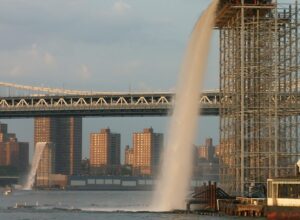
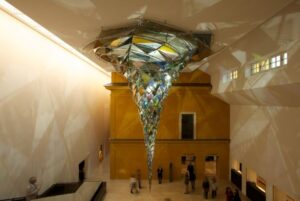 spent summers and holidays. Taking after his father, Olafur had his first solo show at 15, exhibiting landscape drawings and gouaches at a small alternative gallery in Denmark. From there, his work grew and expanded into abstracts, which is where his fame came from. The “Umschreibung” was designed and built in 2004. Another of his cool structures is the New York City Waterfalls, and there are many others too.
spent summers and holidays. Taking after his father, Olafur had his first solo show at 15, exhibiting landscape drawings and gouaches at a small alternative gallery in Denmark. From there, his work grew and expanded into abstracts, which is where his fame came from. The “Umschreibung” was designed and built in 2004. Another of his cool structures is the New York City Waterfalls, and there are many others too.
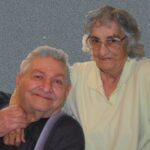
 Bill Beadle became my uncle when he married my Aunt Virginia (Byer) Beadle. Uncle Bill was a fun sort of man who always loved to tease the little kids. That made him a favorite of all the kids. You could always tell when Uncle Bill was in a teasing mood, because he would get a twinkle in his eye. I think he was a tickled by the laughter of the kids as they were by his jokes and teasing.
Bill Beadle became my uncle when he married my Aunt Virginia (Byer) Beadle. Uncle Bill was a fun sort of man who always loved to tease the little kids. That made him a favorite of all the kids. You could always tell when Uncle Bill was in a teasing mood, because he would get a twinkle in his eye. I think he was a tickled by the laughter of the kids as they were by his jokes and teasing.
All joking aside, Uncle Bill was raised a hardworking Wyoming man. Born in Worland, he would never live anywhere but Wyoming. He loved everything Wyoming had to offer…hunting and fishing, as well as the great outdoors. Wyoming checked all his boxes, and he was always happy here, and I can see that. While I may not love the cold winter months, Wyoming is a beautiful place and a very nice place to live. A Westerner at heart, his favorite show were Westerns. In fact, he loved all things cowboy, western, and especially the Old West. I suppose it might seem possible that he was living in the wrong era. I think he would have really enjoyed living in the Old West, but we were all born into the era we should be in, and the Old West wasn’t his era.
Uncle Bill led a busy life for most of his life. He worked for years in pipe yards, and later had his own rathole drilling company with his sons, Forrest and Steve. He was an excellent machinist and mechanic. He could fix just about anything. That made him an asset to any employer, as well as a capable businessman.
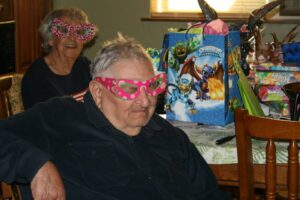 Uncle Bill was an unobtrusive person, who didn’t try to demand attention. That is probably why, at family gatherings, he could be found in a corner of the room. If the kids wanted to hear his jokes, they knew where to find him, and while he didn’t try for their attention, it really pleased him when they sought him out for a few laughs. Always quick with the jokes, the kids were never disappointed when Uncle Bill got going. I’m sure that is why we all missed him when his memory began to go, and he couldn’t really socialize at the family events anymore. The day he started staying home was a sad one for sure. Today would have been Uncle Bill’s 94th birthday. Happy birthday in Heaven, Uncle Bill. We love and miss you very much.
Uncle Bill was an unobtrusive person, who didn’t try to demand attention. That is probably why, at family gatherings, he could be found in a corner of the room. If the kids wanted to hear his jokes, they knew where to find him, and while he didn’t try for their attention, it really pleased him when they sought him out for a few laughs. Always quick with the jokes, the kids were never disappointed when Uncle Bill got going. I’m sure that is why we all missed him when his memory began to go, and he couldn’t really socialize at the family events anymore. The day he started staying home was a sad one for sure. Today would have been Uncle Bill’s 94th birthday. Happy birthday in Heaven, Uncle Bill. We love and miss you very much.
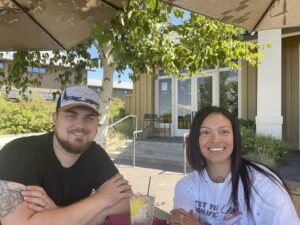
 When my niece, Gaby Beach and my nephew, Allen Beach left Wyoming for Eugene, Oregon, it was as close to going home for Gaby, as she has been in years. Gaby’s family also lives in Oregon, although not Eugene. They are about an hour away from what I understand. Still for a number of years while Gaby was in the Navy, and going to college in Wyoming, she was often as far away from her family as it gets, specifically Japan, Wyoming, and Maryland. That made frequent visits to see them a major undertaking, and not a simple hour drive. I know that she missed them, and they missed her. It’s just never easy to live far away from your family. Now, with this move back to Oregon, where, as Gaby puts it, “her heart is,” they get much more frequent visits. I am happy for them, even though that means that we don’t get to see Gaby and Allen as much.
When my niece, Gaby Beach and my nephew, Allen Beach left Wyoming for Eugene, Oregon, it was as close to going home for Gaby, as she has been in years. Gaby’s family also lives in Oregon, although not Eugene. They are about an hour away from what I understand. Still for a number of years while Gaby was in the Navy, and going to college in Wyoming, she was often as far away from her family as it gets, specifically Japan, Wyoming, and Maryland. That made frequent visits to see them a major undertaking, and not a simple hour drive. I know that she missed them, and they missed her. It’s just never easy to live far away from your family. Now, with this move back to Oregon, where, as Gaby puts it, “her heart is,” they get much more frequent visits. I am happy for them, even though that means that we don’t get to see Gaby and Allen as much.
When they made to decision to move, Gaby applied to several places. As a nurse, she accepted a position with the Veteran’s Administration, working in a VA Hospital. As a veteran herself, veterans hold a special place in her 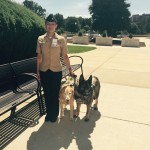 heart. Unfortunately, with things the way they are in our nation, there is a bit of a shortage of doctors everywhere, which includes her hospital. That puts more responsibility on the nurses than ever. While they can’t diagnose, they can care for patients who have been diagnosed already. So, upon her arrival, Gaby dove right in and got to work nursing the men and women who had gone through some or more of the same things she had. Gaby understands what they are going through, even if many of them are quite a bit older than she is. There are also many who are younger and have been wounded or who suffer from things like PTSD. Part of Gaby’s job is to schedule vets for appointments and procedures too. They need a lot of care, and like the doctor shortage, there is also a nurse shortage in our nation, making Gaby a very valuable asset to the VA Hospital in Eugene, or anywhere else for that matter.
heart. Unfortunately, with things the way they are in our nation, there is a bit of a shortage of doctors everywhere, which includes her hospital. That puts more responsibility on the nurses than ever. While they can’t diagnose, they can care for patients who have been diagnosed already. So, upon her arrival, Gaby dove right in and got to work nursing the men and women who had gone through some or more of the same things she had. Gaby understands what they are going through, even if many of them are quite a bit older than she is. There are also many who are younger and have been wounded or who suffer from things like PTSD. Part of Gaby’s job is to schedule vets for appointments and procedures too. They need a lot of care, and like the doctor shortage, there is also a nurse shortage in our nation, making Gaby a very valuable asset to the VA Hospital in Eugene, or anywhere else for that matter.
Being from Oregon, which does have a milder climate than we have here in Wyoming, Gaby is really enjoying that part of returning home. She and Allen love the outdoors and hiking, and Oregon has lots of places for them to enjoy one of their favorite pastimes. Gaby is also a “plant fanatic” and there are lots of different plants there for her to experiment with. They decided to lease an apartment for now, so they could get to know Eugene and thereby, decide where they want to live in the city. I don’t recall ever being there, so I have only seen pictures 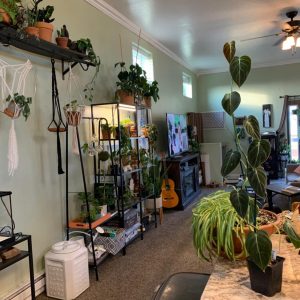
 on Gaby and Allen’s Facebooks. Nevertheless, like them, I love to hike, and it really does look like a beautiful area for lots of long hikes in the wilderness areas there. I know there will also be some great opportunities for my sister and Allen’s mom, Caryl Reed and her husband, Mike Reed; as well as Allen’s sister, Andrea Beach and her son Chris Spicer to go and visit too. While we miss Gaby and Allen, it’s all good, as long as they are happy where they are and they seem to be, so we are too. Today is Gaby’s birthday. Happy birthday Gaby!! Have a great day!! We love you!!
on Gaby and Allen’s Facebooks. Nevertheless, like them, I love to hike, and it really does look like a beautiful area for lots of long hikes in the wilderness areas there. I know there will also be some great opportunities for my sister and Allen’s mom, Caryl Reed and her husband, Mike Reed; as well as Allen’s sister, Andrea Beach and her son Chris Spicer to go and visit too. While we miss Gaby and Allen, it’s all good, as long as they are happy where they are and they seem to be, so we are too. Today is Gaby’s birthday. Happy birthday Gaby!! Have a great day!! We love you!!
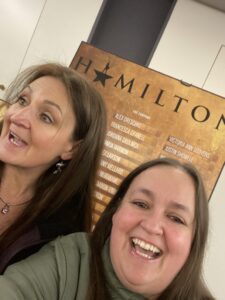
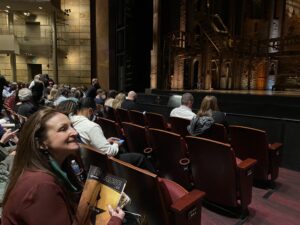 My nieces, Toni Chase and Liz Masterson are sisters, and when they get together…well, it can get hilarious. Last March, Toni had two tickets to go to the Broadway production of “Hamilton” in Denver. Like many men, her husband, Dave Chase was less than enthusiastic about going to a Broadway play, so he offered his ticket to his sister-in-law, Liz, who was thrilled to take it. This was going to be an amazing sister trip, and the girls were very excited about it. They had a great time at the play, but as thrilled as they were, and as fun as the play was, the drive to Denver was…less than thrilling. While they are sisters, these girls are polar opposites!! Liz is a very laid-back person. Toni, on the other hand, is very vivacious, or Liz might call it paranoid!! Of the trip, Liz says, “Going to ‘Hamilton’ with Toni was awesome. It was a major treat for me, and I would not have been able to go if Dave hadn’t given me his ticket. So, it was a lot of fun…except for one thing. Toni is not a good
My nieces, Toni Chase and Liz Masterson are sisters, and when they get together…well, it can get hilarious. Last March, Toni had two tickets to go to the Broadway production of “Hamilton” in Denver. Like many men, her husband, Dave Chase was less than enthusiastic about going to a Broadway play, so he offered his ticket to his sister-in-law, Liz, who was thrilled to take it. This was going to be an amazing sister trip, and the girls were very excited about it. They had a great time at the play, but as thrilled as they were, and as fun as the play was, the drive to Denver was…less than thrilling. While they are sisters, these girls are polar opposites!! Liz is a very laid-back person. Toni, on the other hand, is very vivacious, or Liz might call it paranoid!! Of the trip, Liz says, “Going to ‘Hamilton’ with Toni was awesome. It was a major treat for me, and I would not have been able to go if Dave hadn’t given me his ticket. So, it was a lot of fun…except for one thing. Toni is not a good 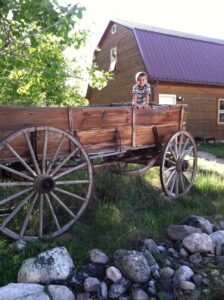
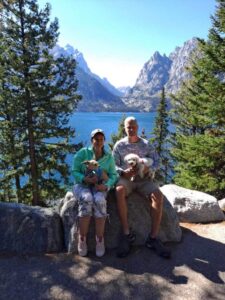 passenger while riding in a big city. She gasped for every little move I made in the car. Imagine grandma reacting to grandpa’s driving and multiply it times 10. Toni is the worst. I don’t know how Dave handles driving with her anywhere.” Hahahaha!! Sisters…right!! They laugh about it too, I’m sure.
passenger while riding in a big city. She gasped for every little move I made in the car. Imagine grandma reacting to grandpa’s driving and multiply it times 10. Toni is the worst. I don’t know how Dave handles driving with her anywhere.” Hahahaha!! Sisters…right!! They laugh about it too, I’m sure.
Toni is truly all about her family. She is very loving and kindhearted. Her daughter-in-law, Manuela Renville says, “Toni is the best mother-in-law, she is super supportive of us, and James is her little baby forever!” Manuela’s family live far away from here, so having a loving mother-in-law is very important, and Toni loves her very much. Toni is also mommy to her two fur babies, puppies, Biscuit and Cricket. Life is good!!
Normally, Toni and Dave would take a number of trips all over, but this was a Wyoming year. They went to Laramie, up through the Snowy Range, and to Cody. The took numerous trips to his mom’s cabin this summer to visit Dave’s mom, as well as his brother and sister, at different times. They spent some time hiking in the 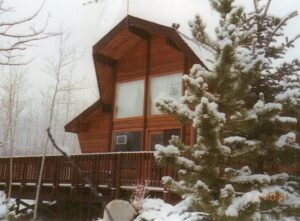
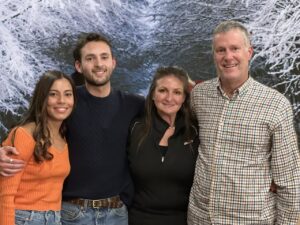 Snowy Range with its beautiful scenery. Toni loves visiting the cabin with her two beloved dogs, and they also love running around the great outdoors. There is just something about that property that restores the soul. It is beautifully laid out and maintained. The minute they arrive, all the tensions of life disappear. It’s a perfect getaway. Today is Toni’s birthday!! Happy birthday Toni!! Have a great day!! We love you!!
Snowy Range with its beautiful scenery. Toni loves visiting the cabin with her two beloved dogs, and they also love running around the great outdoors. There is just something about that property that restores the soul. It is beautifully laid out and maintained. The minute they arrive, all the tensions of life disappear. It’s a perfect getaway. Today is Toni’s birthday!! Happy birthday Toni!! Have a great day!! We love you!!
 As a kid, I, like most kids used to love to shuffle around on a carpeted floor and then touch my friends or better yet, my sisters. The shock of static electricity made everyone jump. IT was one of those sneaky tricks that backfired on the person who set out to pull the sneaky trick in the first place. Of course, there were also times when the shock was completely unintentional, and too both people by surprise. The reality is that while we had fun doing it as kids, static electricity really hurts.
As a kid, I, like most kids used to love to shuffle around on a carpeted floor and then touch my friends or better yet, my sisters. The shock of static electricity made everyone jump. IT was one of those sneaky tricks that backfired on the person who set out to pull the sneaky trick in the first place. Of course, there were also times when the shock was completely unintentional, and too both people by surprise. The reality is that while we had fun doing it as kids, static electricity really hurts.
Kids grow out of the enjoyment of shocking their friends pretty quickly…probably because it really does hurt. Nevertheless, that doesn’t mean that our electric personalities just go away, because they don’t. These days my electric personality works a little differently. You see, I walk, every day, and a lot. In the winter, that’s not so easy, because I am not a “Winter Girl” and that’s a fact. So, my Wintertime trail of choice is not the mall, or a shopping center in town, but rather it’s the “Carpet Trail” in my house. My house has two entrances into my  galley kitchen. That makes a circle, and with the rest of my house, I can walk with only one turn around spot. The trail works perfectly for me, and I don’t have to go out in the Winter cold. The problem, for me, is that while I don’t shuffle in my walking, my carpet still produces static electricity, and the one who most often gets zapped, is me. Of course, my husband, Bob isn’t immune. He just isn’t the one who gets zapped the most.
galley kitchen. That makes a circle, and with the rest of my house, I can walk with only one turn around spot. The trail works perfectly for me, and I don’t have to go out in the Winter cold. The problem, for me, is that while I don’t shuffle in my walking, my carpet still produces static electricity, and the one who most often gets zapped, is me. Of course, my husband, Bob isn’t immune. He just isn’t the one who gets zapped the most.
“Static electricity is an imbalance of electric charges within or on the surface of a material or between materials. The charge remains until it is able to move away by means of an electric current or electrical discharge. Static electricity is named in contrast with current electricity, where the electric charge flows through an electrical conductor or space and transmits energy.” Of course, we didn’t need the scientific definition of it, because we all know what it’s like. You can see it as you touch the doorknob, and it makes your hair stand on end… especially after rubbing it with a balloon.
especially after rubbing it with a balloon.
Now, I find that today, January 9, 2023, is actually National Static Electricity Day. So, if you used to be one of those people who liked to shuffle around on carpeted floors wearing socks just to zap people, then Static Electricity Day is your day! The idea is to try and find a way to experiment with static electricity on this day…seriously!! They say that you might find that it’s shockingly good fun. Maybe, but in my world of being shocked by every doorknob, electrical devise, my stove, and my husband…several times in the same two hour walk, I don’t know that I would find this day so funny, because I have to “prepare myself” to touch anything, since things often strike back.
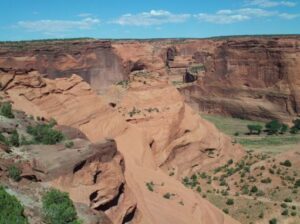
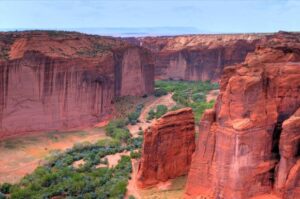 Arizona…home of the Grand Canyon and Monument Valley, is famous for its red dirt and colorful formations, but these places aren’t the only famous places in the area. In fact, the Canyon de Chelly National Monument, which is located in Apache County, Arizona, and is in the current day Navajo Nation, is one of the most visited national monuments in the United States. The strange thing is that there are many people who have never heard of it…me included, and I have been to the Four Corners region. I guess that at the time my family went there, the Four Corners (the spot where four states meet) was more interesting to us. Or maybe it was that we were headed to the Grand Canyon. Anyway, I had not heard of the Canyon de Chelly. My older sister, Cheryl Masterson might find that amusing, and might even tell me that we have been there, but for some reason, if we have been there, I don’t recall.
Arizona…home of the Grand Canyon and Monument Valley, is famous for its red dirt and colorful formations, but these places aren’t the only famous places in the area. In fact, the Canyon de Chelly National Monument, which is located in Apache County, Arizona, and is in the current day Navajo Nation, is one of the most visited national monuments in the United States. The strange thing is that there are many people who have never heard of it…me included, and I have been to the Four Corners region. I guess that at the time my family went there, the Four Corners (the spot where four states meet) was more interesting to us. Or maybe it was that we were headed to the Grand Canyon. Anyway, I had not heard of the Canyon de Chelly. My older sister, Cheryl Masterson might find that amusing, and might even tell me that we have been there, but for some reason, if we have been there, I don’t recall.
The name, Canyon de Chelly is an unusual name for the United States, even in the Southwest. It sounds a bit French, but in reality, it is universal Spanish. “Chelly” is actually derived from the Navajo word tseg, which means “rock canyon” or “in a canyon.” Spanish explorers and government officials began to utilize a “Chelly,” “Chegui,” and even “Chelle” in order to try to replicate the Navajo word in the early 1800s. Eventually, the name was standardized to “de Chelly” by the middle of the 19th century. It is thought that the canyons of de Chelly contain the artifacts and homes of Native Americans as far back as 5,000 years. At first, they lived in caves and the only real evidence of their existence is the hieroglyphics etched into the red rock walls. These people were more nomadic, and so only visited the canyons while on hunting expeditions.
Later the people who lived there were more established, and so began the period of time when the adobe structures were formed. I think that anyone who has seen adobe home, in pictures or in person would have to admit that they are very interesting. It seems so amazing to me that these people could not only make a structure that could withstand the elements as well as these structures have, but to build them on the face of the cliffs is even more amazing. Adobe, of course, is a type of construction material made from a mixture of mud, straw, and water. It is commonly used in hot, dry climates, such as in the southwestern United States. Like any home, renovation took place over the years, strengthening and changing the structures. The structures have names such as Standing Cow (named for the hieroglyphic white bull on the wall above the home), white house (so named because of a white wall in the back of the structure), Mummy Cave (I don’t believe any mummies were found there, so I’m not sure how it got its name), and Antelope House (named for the hieroglyphic carvings of antelope above it). The homes in Canyon de Chelly were abandoned around 1300, although no one really knows why. Over the past century, archaeologists, historians, and scientists have tried to pinpoint the root causes of the massive abandonment of settlements like Hovenweep, Chaco Canyon, and Mesa Verde, but there is no single consensus among experts. It might have been due to warfare, severe drought, food shortages, infectious diseases, or the emergence of new religious and cultural centers. Whatever the 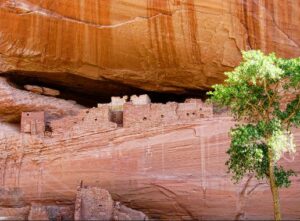
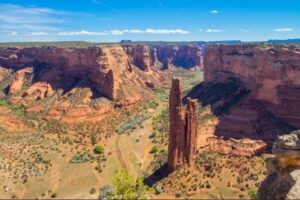 reasons, Canyon de Chelly’s people left the area and migrated south toward the more fertile Rio Grande Valley in present-day New Mexico or toward the Little Colorado River Basin in what is present-day Arizona. That is known because of the homes built in the same fashion in the Pueblos of New Mexico, the Zuni, and the Hopi Indian areas, where the structures still have the rich traditions in artistic and architectural design.
reasons, Canyon de Chelly’s people left the area and migrated south toward the more fertile Rio Grande Valley in present-day New Mexico or toward the Little Colorado River Basin in what is present-day Arizona. That is known because of the homes built in the same fashion in the Pueblos of New Mexico, the Zuni, and the Hopi Indian areas, where the structures still have the rich traditions in artistic and architectural design.

